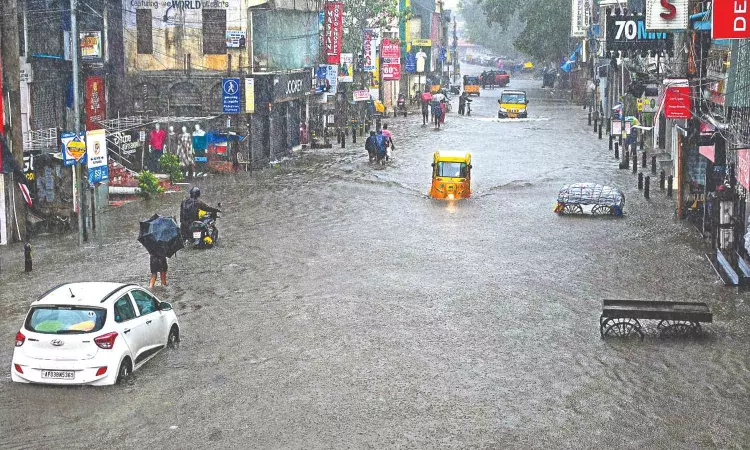Climate action requires debt relief
Developing countries are caught in a vicious cycle of debt distress and climate vulnerability, where rising borrowing costs and climate risks curtail growth and strain public budgets. Breaking free will require reforms that combine climate finance, debt relief, government investment, and private capital

Representative image
Vera Songwe & Moritz Kraemer
Today’s global economic turmoil is not just about trade. As G20 finance ministers gather in Washington this week during the annual spring meetings of the International Monetary Fund and World Bank, IMF Managing Director Kristalina Georgieva has warned that growing economic uncertainty and financial market stress pose serious threats to developing countries.
The danger is particularly acute for highly indebted economies, which are now facing weaker growth prospects and reduced financial support from the United States and other donor countries. In February, the IMF estimated that nearly half of the lowest-income countries were at risk of debt distress, at which point they may no longer be able to meet their debt obligations. That number is expected to rise as conditions continue to deteriorate.
Compounding the crisis, the world’s poorest countries – especially small island developing states – are highly vulnerable to climate change and biodiversity loss. Extreme weather events like hurricanes, droughts, and floods can wipe out critical infrastructure and cripple agricultural production in an instant, while slower-onset changes like rising temperatures and shifting rainfall patterns require continuous and costly adaptation measures.
The debt and climate crises are closely intertwined. As more public funds are diverted toward disaster relief and recovery, fewer resources are available for climate adaptation, nature conservation, and long-term investment. This, in turn, increases vulnerability, weakens growth prospects, and drives up borrowing costs, shrinking fiscal space even further. The result is a self-reinforcing, vicious circle.
But it doesn’t have to be this way. Over the past year, we have co-chaired the Expert Review on Debt, Nature, and Climate – an initiative launched by the governments of Colombia, Kenya, France, and Germany. In our final report, “Healthy Debt on a Healthy Planet,” we outline several steps that emerging and developing economies can take to break free from the debt-climate trap and move toward a virtuous cycle of low-carbon, climate-resilient, and nature-positive growth.
First, climate and nature considerations must be integrated into macroeconomic and fiscal analyses. This is especially critical in the debt sustainability frameworks used by the IMF and World Bank to assess developing countries’ fiscal health. Although both institutions have made some progress in recent years, much more needs to be done to ensure that these frameworks fully account for climate-related risks.
Equally important, such assessments must recognise not only the risks posed by climate change but also the economic benefits of investing in resilience. Their value – especially their potential to fuel medium-term growth and reduce a country’s financial risks – must be properly reflected in economic and financial models to encourage governments to act.
Second, many developing countries need assistance in reducing their debt burdens. Some are already in debt distress, while others suffer from liquidity problems. Our report proposes new mechanisms for restructuring and refinancing debt in return for investments in climate adaptation and conservation projects that promote sustainable growth. Borrower countries, major global creditors, the IMF, and multilateral development banks (MDBs) must all champion such solutions.
Third, proven approaches to addressing debt, nature, and climate risks must be scaled up. These include contingency clauses in debt contracts that suspend repayments during natural disasters and various forms of sustainability-linked finance. While debt-for-climate and debt-for-nature swaps are not yet scalable due to a lack of standardisation, they have already delivered vital funding for environmental initiatives, demonstrating their value and warranting greater support.
More broadly, MDBs must significantly boost lending to support low-carbon, climate-resilient, and nature-positive growth. While discussions on much-needed recapitalisation are ongoing, optimising MDB balance sheets remains the most effective way to stretch scarce public resources and accelerate sustainable development.
Lastly, our report calls for the development of new financing instruments aimed at mobilizing private capital for climate mitigation and adaptation. For example, we propose establishing a Finance Facility against Climate Change (F2C2) – a special-purpose vehicle designed to issue green bonds backed by future donor commitments. The proceeds would be directed primarily toward climate-mitigation investments in developing countries. If successful, the F2C2 could unlock up to $1 trillion in private financing.
We also propose a new kind of equity-like instrument to finance climate-resilient infrastructure. Investments in sea walls, flood defences, and similar systems can significantly reduce the costs of disaster relief and recovery. As the primary beneficiaries, insurance companies must work together with MDBs to develop an instrument capable of translating these savings into returns for investors.
These are all practical, actionable proposals. When combined with technical assistance and policy support, they could significantly improve the growth prospects of developing countries grappling with debt and climate risks. Making debt management both fiscally and environmentally sustainable is not only feasible but also essential to safeguarding global growth, which is in the interest of all countries – not just the poorest.
Vera Songwe, a former under-secretary-general at the United Nations, is Co-Chair of the Expert Review on Debt, Nature, and Climate Moritz Kraemer, a former global chief ratings officer at S&P Global, is Co-Chair of the Expert Review on Debt, Nature, and Climate



